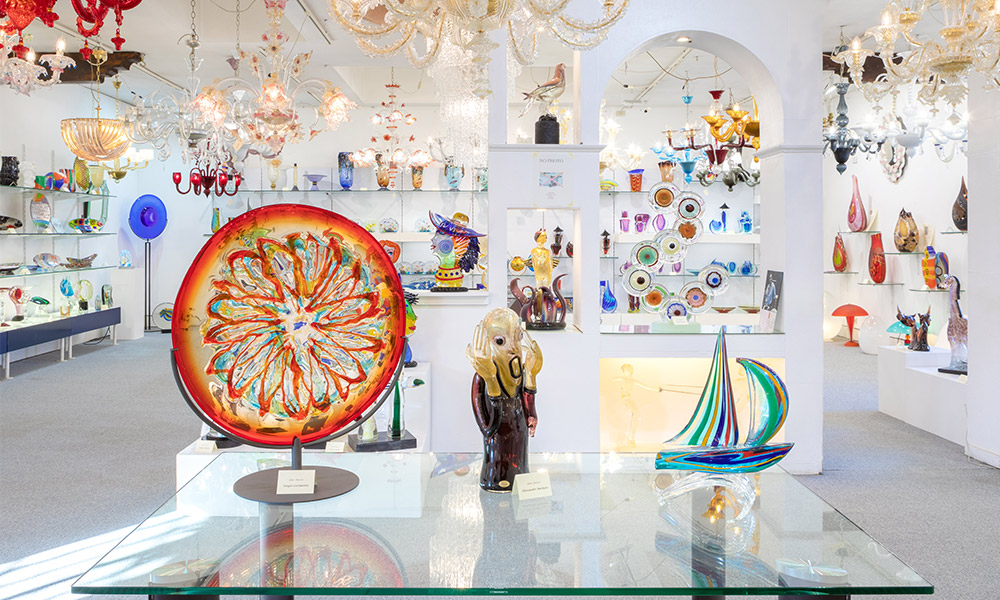Italian Murano glass Italy, world-renowned for its exceptional beauty and craftsmanship, is a true testament to the artistry and skill of Italian glassmakers. Originating from the island of Murano in Venice, Italy, this ancient tradition has captivated the world with its intricate designs, vibrant colours, and exquisite forms. In this article, we will take you on a journey through the fascinating process of creating Murano glass, a cherished art form that has endured for centuries.
A Storied History
The history of Italian Murano glass glassmaking dates to the 13th century, when the Republic of Venice ordered glassmakers to relocate to the island of Murano. This move was intended to prevent the risk of fire in Venice’s densely populated and mostly wooden city centre, as glassmaking required intense heat. Over the centuries, Murano glassmakers honed their craft, developing techniques that remain a closely guarded secret to this day.
Materials
The primary materials used in Murano glassmaking are silica sand, soda ash, and lime. These raw materials are mixed to create a soda-lime glass base. What sets Murano glass apart is the addition of various minerals and metal oxides to achieve the desired colours and effects. For example, the addition of cobalt produces deep blue, while gold chloride creates a rich red hue.
The Muranese Furnace
The heart of the Murano glass workshop is the furnace. A traditional cone-shaped furnace is used, fuelled by a mixture of gas and air. The furnace can reach temperatures exceeding 1,800 degrees Celsius (3,272 degrees Fahrenheit), hot enough to melt glass to a molten state.
Blowing and Shaping
The glassmaking process begins with a skilled artisan gathering a small amount of molten glass on the end of a blowpipe, a long metal tube. The artisan then blows into the pipe, creating a small bubble that serves as the foundation of the glass piece. The glass is continually heated and shaped using various tools, moulds, and techniques, depending on the desired design.
Millefiori and Filigree
Two iconic techniques in Murano glassmaking are millefiori and filigree. Millefiori, which means “a thousand flowers” in Italian, involves creating intricate patterns by layering and fusing glass canes of various colours and designs. Filigree, on the other hand, entails twisting and layering thin glass rods to form delicate patterns within the glass.
Gold and Silver Leaf
Murano glass is often adorned with gold and silver leaf. These precious metals are applied in the form of extremely thin sheets, which are carefully layered onto the glass and then sealed within the glass surface. This technique creates a dazzling effect, especially when the glass is illuminated.
Annealing and Cooling
Once the glass piece has taken its final form, it is placed in an annealing oven, where it undergoes a controlled cooling process. This gradual cooling prevents stress and cracking in the glass, ensuring its durability and stability.
Cutting and Polishing
After annealing, the glass is often cut and polished to refine its shape and remove any imperfections. This step requires great precision and craftsmanship, as it can significantly enhance the final appearance of the piece.
The Endless Varieties
The world of Murano glass is incredibly diverse, offering an array of stunning products, from delicate glass figurines and intricate chandeliers to colourful vases and exquisite jewellery. Each piece is a testament to the skill and artistry of the glassmakers who have dedicated their lives to this time-honoured craft.
Preserving Tradition
Today, the art of Murano glassmaking continues to thrive, passed down from one generation to the next. Artisans and glassmakers on the island of Murano are committed to preserving this ancient tradition while also embracing modern innovations. Murano glass remains a symbol of Italy’s rich cultural heritage and a source of inspiration for artists and collectors worldwide.
In conclusion, the art of creating Murano glass is a captivating journey through centuries of tradition, skill, and creativity. Each piece is a testament to the dedication of Italian artisans who continue to craft these exquisite works of art, ensuring that the legacy of Murano glass lives on for generations to come.

